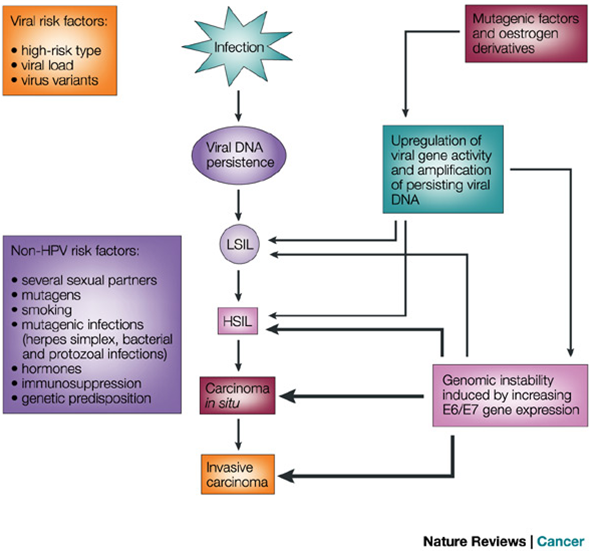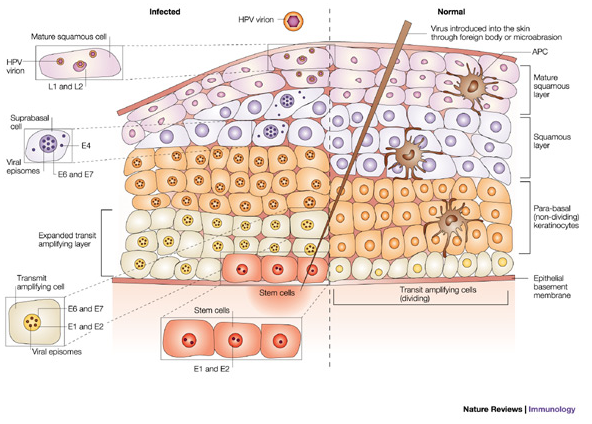This content is also available in:
English
Italiano
Português
Čeština
Română
Türkçe

Schlüsselproteine, die die HPV DNA codieren
Das Genom des HPV ist eine ringförmige, doppelsträngige DNA, die 6800-8000 Basenpaare lang ist. Das Genom codiert für 8 Gene. Aufgeteilt werden sie, je nach Stadium der Basalzellinfektion in frühe Virusproteine E1, E2, E4, E5, E6, und E7, sowie L1 und L2, als späte Strukturproteine. Schlüsselproteine siehe Abbildlung 3.6.

Mechanism of HPV infection
As previously mentioned, the squamous epithelium acts as a protective ‘skin’ to keep pathogens from infecting the underlying tissue. Even though the cervix is not an externally exposed tissue it is still subject to the external environment, especially during sexual intercourse. The HPV is able to get through the protective layers of the squamous epithelium through epithelial abrasions to commence its infective life cycle.

HPV-Integration in das Genom der Wirtszelle
Die Integration der Virus-DNA in das Genom der Wirtszelle verursacht vornehmlich 2 Auswirkungen, die schließlich zur Tumorentstehung führen.
- Blockierung des programmierten Zelltods (Apoptose)
- Blockierung der Synthese von Regulatorproteinen, was eine unkontrollierte Zellteilung nach sich zieht
Es gibt zwei wesentliche Gene des HPV Genoms, die eine zentrale Rolle in der Tumorentstehung spielen, E6 verhindert die Aktivität von p53 und
E7 blockiert die Funktion von Retinoblastomprotein (Rb). Diese beiden Proteine, p53 und Rb spielen physiologischerweise in der Reparatur von Zellen mit beschädigter/mutierter DNA eine wesentliche Rolle.
Das p53 Gen codiert ein Schlüsselprotein, das in normal wachsenden Zellen bei der Regulation des Zellzyklus nach DNA-Schädigung beteiligt ist. Liegt in einer Zelle geschädigte DNA vor, wird p53 in der Zelle akkumuliert, das bewirkt eine Aktivierung anderer Proteine, die schlußendlich zum programmierten Zelltod (Apoptose) der geschädigten Zelle führen. Bindet nun jedoch E6 des HPV an p53 der Wirtszelle, bedingt das eine strukturelle Veränderung von p53, diese neue Variante von p53 ist dann außerstande an geschädigte DNA zu binden. In weiterer Folge, wird die Kaskade der Apoptose mit p21 unfähig als “Stop-Signal” im Zellzyklus zu fungieren und die mutierte Zelle kann sich unkontrolliert teilen.
Das Rb Gen codiert ein Protein, das die Zelle davor schützt beschädigte DNA zu replizieren, indem die Zelle am Durchlaufen des Zellzyklus durch die G1-Phase zur S-Phase gehindert wird. Wenn allerdings das E7 Protein des HPV an Rb Protein bindet ist es nicht mehr länger funktionsfähig und die Zellproliferation verläuft ohne Gegensteuerung.
Learning points from Chapter 3
|

